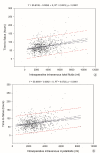Effect of intraoperative fluid volume on postoperative ileus after robot-assisted radical cystectomy
- PMID: 34006918
- PMCID: PMC8131600
- DOI: 10.1038/s41598-021-89806-z
Effect of intraoperative fluid volume on postoperative ileus after robot-assisted radical cystectomy
Abstract
This study aimed to investigate the effect of intraoperative fluid volume on the postoperative ileus (POI) recovery period. A retrospective review of the Korean robot-assisted radical cystectomy database identified 718 patients who underwent robot-assisted radical cystectomy (RARC). Regression analyses were performed to identify the associations between the amount of intraoperative fluid administration (crystalloid/colloid/total), POI period (time to flatus/bowel movements), and length of hospital stay (LOS) after adjusting for covariates. In addition, we analyzed the risk factors for gastrointestinal complications and prolonged POI using a logistic regression model. An increasing volume of the administered crystalloid/total fluid was associated with prolonged POI (crystalloid R2 = 0.0725 and P < 0.0001; total amount R2 = 0.0812 and P < 0.0001), and the total fluid volume was positively associated with the LOS (R2 = 0.099 and P < 0.0001). The crystalloid amount was a risk factor for prolonged POI (P < 0.001; odds ratio, 1.361; 95% confidence interval, 1.133-1.641; P < 0.001). In the context of RARC, increased intravenous fluids are associated with prolonged POI and longer LOS.
Conflict of interest statement
The authors declare no competing interests.
Figures


Similar articles
-
Analgesic opioid dose is an important indicator of postoperative ileus following radical cystectomy with ileal conduit: experience in the robotic surgery era.Yonsei Med J. 2014 Sep;55(5):1359-65. doi: 10.3349/ymj.2014.55.5.1359. Yonsei Med J. 2014. PMID: 25048497 Free PMC article.
-
Risk factors for postoperative ileus after robot-assisted radical cystectomy with intracorporeal urinary diversion.Int J Urol. 2022 Jun;29(6):553-558. doi: 10.1111/iju.14839. Epub 2022 Mar 1. Int J Urol. 2022. PMID: 35229914
-
Impact of an enhanced recovery protocol in frail patients after intracorporeal urinary diversion.BJU Int. 2024 Sep;134(3):426-433. doi: 10.1111/bju.16340. Epub 2024 Mar 19. BJU Int. 2024. PMID: 38500447
-
Current perioperative management of radical cystectomy with intestinal urinary reconstruction for muscle-invasive bladder cancer and reduction of the incidence of postoperative ileus.Surg Oncol. 2008 Jul;17(1):41-8. doi: 10.1016/j.suronc.2007.09.003. Epub 2007 Oct 24. Surg Oncol. 2008. PMID: 17962014 Review.
-
Comparison of perioperative complications and health-related quality of life between robot-assisted and open radical cystectomy: A systematic review and meta-analysis.Int J Urol. 2019 Aug;26(8):760-774. doi: 10.1111/iju.14005. Epub 2019 May 13. Int J Urol. 2019. PMID: 31083783 Free PMC article.
Cited by
-
Identification of risk factors and clinical model construction of abdominal distension after radical cystectomy.Transl Androl Urol. 2022 Dec;11(12):1629-1636. doi: 10.21037/tau-22-455. Transl Androl Urol. 2022. PMID: 36632150 Free PMC article.
-
Goal-directed fluid therapy using stroke volume variation on length of stay and postoperative gastrointestinal function after major abdominal surgery-a randomized controlled trial.BMC Anesthesiol. 2023 Dec 4;23(1):397. doi: 10.1186/s12871-023-02360-1. BMC Anesthesiol. 2023. PMID: 38049713 Free PMC article. Clinical Trial.
-
Comparison of perioperative outcomes and complications between intracorporeal, extracorporeal, and hybrid ileal conduit urinary diversion during robot-assisted radical cystectomy: a comparative propensity score-matched analysis from nationwide multi-institutional study in Japan.Int J Clin Oncol. 2024 Jan;29(1):64-71. doi: 10.1007/s10147-023-02425-8. Epub 2023 Oct 21. Int J Clin Oncol. 2024. PMID: 37864612
-
Personalized risk prediction for prolonged ileus after minimally invasive colorectal cancer surgery: in-depth risk factor analysis and model development.Int J Colorectal Dis. 2024 Jul 23;39(1):115. doi: 10.1007/s00384-024-04693-w. Int J Colorectal Dis. 2024. PMID: 39042270 Free PMC article.
-
Preoperative smoking and robot-assisted radical cystectomy outcomes & complications in multicenter KORARC database.Sci Rep. 2024 May 8;14(1):10550. doi: 10.1038/s41598-024-61005-6. Sci Rep. 2024. PMID: 38719836 Free PMC article.
References
Publication types
MeSH terms
LinkOut - more resources
Full Text Sources
Other Literature Sources
Medical

